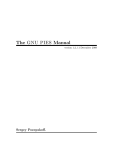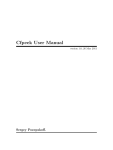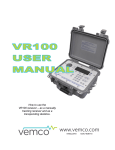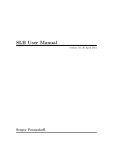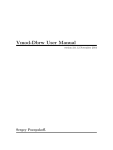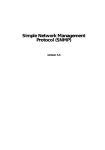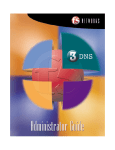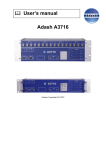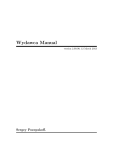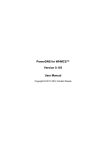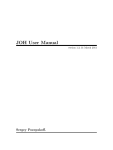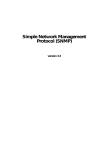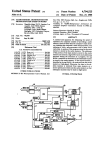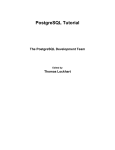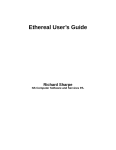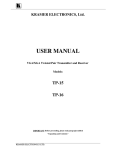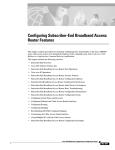Download NSSYNC - Puszcza
Transcript
NSSYNC
version 1.1.91, 1 December 2014
Sergey Poznyakoff
Published by the Free Software Foundation, 51 Franklin Street, Fifth Floor,
Boston, MA 02110-1301 USA
c 2012 Sergey Poznyakoff
Copyright Permission is granted to copy, distribute and/or modify this document under the terms of the GNU Free Documentation License, Version 1.3 or any
later version published by the Free Software Foundation; with no Invariant
Sections, an no specific Front- or Back-Cover texts.
i
Short Contents
1 Introduction . . . . . . . . . . . . . . . . . . . . . . . . . . . . . . . . . . . . . . . . . 1
2 Overview . . . . . . . . . . . . . . . . . . . . . . . . . . . . . . . . . . . . . . . . . . . . 3
3 Configuration File . . . . . . . . . . . . . . . . . . . . . . . . . . . . . . . . . . . . . 5
4 Nssync Configuration . . . . . . . . . . . . . . . . . . . . . . . . . . . . . . . . . 11
5 Invocation . . . . . . . . . . . . . . . . . . . . . . . . . . . . . . . . . . . . . . . . . . 17
6 Exit Codes . . . . . . . . . . . . . . . . . . . . . . . . . . . . . . . . . . . . . . . . . 19
7 How to Report a Bug . . . . . . . . . . . . . . . . . . . . . . . . . . . . . . . . . 21
A GNU Free Documentation License . . . . . . . . . . . . . . . . . . . . . . . 23
Concept Index . . . . . . . . . . . . . . . . . . . . . . . . . . . . . . . . . . . . . . . . . . 33
iii
Table of Contents
1
Introduction . . . . . . . . . . . . . . . . . . . . . . . . . . . . . . . . . . . . . 1
2
Overview . . . . . . . . . . . . . . . . . . . . . . . . . . . . . . . . . . . . . . . . 3
3
Configuration File . . . . . . . . . . . . . . . . . . . . . . . . . . . . . . 5
3.1
3.2
3.3
3.4
4
Comments . . . . . . . . . . . . . . . . . . . . . . . . . . . . . . . . . . . . . . . . . . . . . . . . . . . . .
Pragmatic Comments . . . . . . . . . . . . . . . . . . . . . . . . . . . . . . . . . . . . . . . . . .
Statements . . . . . . . . . . . . . . . . . . . . . . . . . . . . . . . . . . . . . . . . . . . . . . . . . . . . .
Preprocessor . . . . . . . . . . . . . . . . . . . . . . . . . . . . . . . . . . . . . . . . . . . . . . . . . . .
5
5
6
8
Nssync Configuration . . . . . . . . . . . . . . . . . . . . . . . . . 11
4.1
4.2
4.3
General Settings . . . . . . . . . . . . . . . . . . . . . . . . . . . . . . . . . . . . . . . . . . . . . . 11
SQL Access . . . . . . . . . . . . . . . . . . . . . . . . . . . . . . . . . . . . . . . . . . . . . . . . . . . 12
Synchronization Block. . . . . . . . . . . . . . . . . . . . . . . . . . . . . . . . . . . . . . . . . 13
5
Invocation . . . . . . . . . . . . . . . . . . . . . . . . . . . . . . . . . . . . . . 17
6
Exit Codes . . . . . . . . . . . . . . . . . . . . . . . . . . . . . . . . . . . . . 19
7
How to Report a Bug . . . . . . . . . . . . . . . . . . . . . . . . . 21
Appendix A GNU Free Documentation License
. . . . . . . . . . . . . . . . . . . . . . . . . . . . . . . . . . . . . . . . . . . . . . . . 23
Concept Index . . . . . . . . . . . . . . . . . . . . . . . . . . . . . . . . . . . . . 33
Chapter 1: Introduction
1
1 Introduction
BIND, the most frequently used DNS server, normally keeps its zone data in
zone files. This approach becomes inconvenient when the number of zones
grows beyond a certain limit. When this happens, the obvious solution is
to move all data to a database and make named read it from there. Recent
versions of BIND include dynamically loadable zones (DLZ) feature1 , which
makes it possible to use such databases directly. However, DLZ has problems
of its own, one of them being that it is unable to propagate glue records2 .
The nssync utility provides an alternative solution, which makes it possible to keep your zone data in an SQL3 database without using DLZ and
with glue records working.
It does so by periodically polling the database to determine which data
have changed recently and converting the database into BIND zone files.
1
2
3
See http://bind-dlz.sourceforge.net/.
See: http://permalink.gmane.org/gmane.network.dns.bind9.dlz/2078, http://
blog.gmane.org/gmane.network.dns.bind9.dlz/month=20110101.
As of version 1.1.91 only MySQL is supported.
Chapter 2: Overview
3
2 Overview
The nssync utility is normally started periodically from crontab. Upon
startup it reads its configuration file, which supplies the necessary program
settings. Then, if the settings require so, it verifies that no other copy of the
nssync is already running. Further on, it parses the named configuration file
named.conf to determine several settings needed for its further operation,
in particular, the value of the ‘directory’ statement in the ‘options’ block.
Once these preliminary operations are over, nssync starts its main task.
Its configuration file defines, among other data, one or more synchronization
blocks. Each such block defines SQL statements which return information
about DNS zones as well as the location of named configuration file where the
zone statements for these zones are to be stored (it is supposed that this file is
included somewhere in the main named.conf file). For each synchronization
block, the utility retrieves the zone data from the database and formats them
into separate zone files. Each of these files is then compared to an already
existing one (locations of the zone files are defined in the synchronization
block they pertain to). If the files differ, new zone file replaces the old one
and a flag is set indicating that the named daemon needs to be restarted in
order to read new configuration.
When this stage is finished, nssync reloads the name server (if required)
and exits.
Several command line options can be supplied in order to modify the
program’s behavior. In particular, it is possible to check the configuration
file syntax or even instruct the utility to do everything, except modifying
the zone files (a so-called dry-run mode). This allows you to debug your
configuration before actually starting using nssync.
Chapter 3: Configuration File
5
3 Configuration File
Nssync reads its settings from a configuration file nssync.conf located normally in the system configuration directory (usually /etc or
/usr/local/etc, depending on compile-time options).
This chapter describes the syntax of that file in general. The chapter
that follows describes the nssync-specific settings in detail.
The configuration file consists of statements and comments.
There are three classes of lexical tokens: keywords, values, and separators.
Blanks, tabs, newlines and comments, collectively called white space are
ignored except as they serve to separate tokens. Some white space is required
to separate otherwise adjacent keywords and values.
3.1 Comments
Comments may appear anywhere where white space may appear in the configuration file. There are two kinds of comments: single-line and multi-line
comments. Single-line comments start with ‘#’ or ‘//’ and continue to the
end of the line:
# This is a comment
// This too is a comment
Multi-line or C-style comments start with the two characters ‘/*’ (slash,
star) and continue until the first occurrence of ‘*/’ (star, slash).
Multi-line comments cannot be nested. However, single-line comments
may well appear within multi-line ones.
3.2 Pragmatic Comments
Pragmatic comments are similar to usual single-line comments, except that
they cause some changes in the way the configuration is parsed. Pragmatic
comments begin with a ‘#’ sign and end with the next physical newline
character.
#include <file>
#include file
Include the contents of the file file. If file is an absolute file
name, both forms are equivalent. Otherwise, the form with angle
brackets searches for the file in the include search path, while
the second one looks for it in the current working directory first,
and, if not found there, in the include search path.
The default include search path is:
1. prefix/share/nssync/1.1.91/include
2. prefix/share/nssync/include
where prefix is the installation prefix.
6
Nssync
#include_once <file>
#include_once file
Same as #include, except that, if the file has already been included, it will not be included again.
#line num
#line num "file"
This line causes the parser to believe, for purposes of error diagnostics, that the line number of the next source line is given
by num and the current input file is named by file. If the latter
is absent, the remembered file name does not change.
# num "file"
This is a special form of #line statement, understood for compatibility with the c preprocessor.
In fact, these statements provide a rudimentary preprocessing features.
For more sophisticated ways to modify configuration before parsing, see
Section 3.4 [Preprocessor], page 8.
3.3 Statements
A simple statement consists of a keyword and value separated by any amount
of whitespace. Simple statement is terminated with a semicolon (‘;’).
The following is a simple statement:
standalone yes;
pidfile /var/run/slb.pid;
A keyword begins with a letter and may contain letters, decimal digits,
underscores (‘_’) and dashes (‘-’). Examples of keywords are: ‘expression’,
‘output-file’.
A value can be one of the following:
number
A number is a sequence of decimal digits.
boolean
A boolean value is one of the following: ‘yes’, ‘true’, ‘t’ or ‘1’,
meaning true, and ‘no’, ‘false’, ‘nil’, ‘0’ meaning false.
unquoted string
An unquoted string may contain letters, digits, and any of the
following characters: ‘_’, ‘-’, ‘.’, ‘/’, ‘@’, ‘*’, ‘:’.
quoted string
A quoted string is any sequence of characters enclosed in doublequotes (‘"’). A backslash appearing within a quoted string introduces an escape sequence, which is replaced with a single
character according to the following rules:
Chapter 3: Configuration File
Sequence
\a
\b
\f
\n
\r
\t
\v
\\
\"
7
Replaced with
Audible bell character (ASCII 7)
Backspace character (ASCII 8)
Form-feed character (ASCII 12)
Newline character (ASCII 10)
Carriage return character (ASCII
13)
Horizontal tabulation character
(ASCII 9)
Vertical
tabulation
character
(ASCII 11)
A single backslash (‘\’)
A double-quote.
Table 3.1: Backslash escapes
In addition, the sequence ‘\newline’ is removed from the string.
This allows to split long strings over several physical lines, e.g.:
"a long string may be\
split over several lines"
If the character following a backslash is not one of those specified
above, the backslash is ignored and a warning is issued.
Two or more adjacent quoted strings are concatenated, which
gives another way to split long strings over several lines to improve readability. The following fragment produces the same
result as the example above:
"a long string may be"
" split over several lines"
Here-document
A here-document is a special construct that allows to introduce
strings of text containing embedded newlines.
The <<word construct instructs the parser to read all the following lines up to the line containing only word, with possible
trailing blanks. Any lines thus read are concatenated together
into a single string. For example:
<<EOT
A multiline
string
EOT
The body of a here-document is interpreted the same way as
a double-quoted string, unless word is preceded by a backslash
(e.g. ‘<<\EOT’) or enclosed in double-quotes, in which case the
text is read as is, without interpretation of escape sequences.
If word is prefixed with - (a dash), then all leading tab characters
are stripped from input lines and the line containing word. Fur-
8
Nssync
thermore, if - is followed by a single space, all leading whitespace
is stripped from them. This allows to indent here-documents in
a natural fashion. For example:
<<- TEXT
The leading whitespace will be
ignored when reading these lines.
TEXT
It is important that the terminating delimiter be the only token
on its line. The only exception to this rule is allowed if a heredocument appears as the last element of a statement. In this case
a semicolon can be placed on the same line with its terminating
delimiter, as in:
help-text <<-EOT
A sample help text.
EOT;
list
A list is a comma-separated list of values. Lists are enclosed in
parentheses. The following example shows a statement whose
value is a list of strings:
alias (test,null);
In any case where a list is appropriate, a single value is allowed
without being a member of a list: it is equivalent to a list with
a single member. This means that, e.g.
alias test;
is equivalent to
alias (test);
A block statement introduces a logical group of statements. It consists
of a keyword, followed by an optional value, and a sequence of statements
enclosed in curly braces, as shown in the example below:
server srv1 {
host 10.0.0.1;
community "foo";
}
The closing curly brace may be followed by a semicolon, although this is
not required.
3.4 Preprocessor
Before actual parsing, the configuration file is preprocessed. The built-in
preprocessor handles only file inclusion and #line statements (see Section 3.2
[Pragmatic Comments], page 5), while the rest of traditional preprocessing
facilities, such as macro expansion, is supported via m4, which serves as
external preprocessor.
The detailed description of m4 facilities lies far beyond the scope of this
document. You will find a complete user manual in Section “GNU M4” in
Chapter 3: Configuration File
9
GNU M4 macro processor. For the rest of this subsection we assume the
reader is sufficiently acquainted with m4 macro processor.
The external preprocessor is invoked with -s flag, which instructs it to
include line synchronization information in its output. This information is
then used by the parser to display meaningful diagnostic.
An initial set of macro definitions is supplied by the pp-setup file, located
in prefix/share/nssync/1.1.91/include directory.
The default pp-setup file renames all m4 built-in macro names so they all
start with the prefix ‘m4_’. This is similar to GNU m4 --prefix-builtin
option, but has an advantage that it works with non-GNU m4 implementations as well.
Chapter 4: Nssync Configuration
11
4 Nssync Configuration
4.1 General Settings
These settings modify the behavior of nssync as a whole.
[Configuration]
At startup, check if file already exists and is owned by an existing process.
Exit if so. Use this statement to avoid accidentally running two copies of
nssync simultaneously.
pidfile file
[Configuration]
Sets the name for the temporary directory. This is a directory where
nssync creates temporary zone files. The argument must point to an
existing directory.
tempdir dir
[Configuration]
If set to true, nssync will check the list of NS servers prior to creating a
zone file. The file will be created only if IPv4 address of one of the servers
matches one of the IP addresses of the host on which nssync is run.
check-ns bool
[Configuration]
Defines the full pathname of the named configuration file. Default is
/etc/named.conf.
named-conf file
[Configuration]
Sets include search path for include directives found in BIND configuration. The argument is either a single directory or a list of directories
(see Section 3.3 [Statements], page 6).
bind-include-path list
[Configuration]
Defines the pattern for zone file names. The name of each zone file is created by expanding variable references in the pat argument. The following
variable references are defined:
zonefile-pattern pat
$zone
${zone}
Name of the zone, without the trailing dot.
$synctag
${synctag}
Zone synchronization tag (see Section 4.3 [Synchronization
Block], page 13).
Both notations (with and without braces) are equivalent. The notation
with curly braces should be used if the reference is immediately followed
by a letter.
The default zone file pattern is ‘$zone.$synctag’.
12
Nssync
[Configuration]
Defines the pattern for zone configuration file, i.e. a file containing zone
statements.
The handling of pat is similar to that in zonefile-pattern, except that
only the ‘$synctag’ reference is defined.
zone-conf pat
[Configuration]
Defines a command to be used for comparing two zone files. The cmd
must be a command taking two files as its arguments and returning 0 if
they are the same or non-zero if they differ. Nssync uses this command to
determine whether a particular zone has changed. The following variable
references are expanded in cmd:
compare-command cmd
$oldfile
${oldfile}
Old zone file.
$newfile
${newfile} New zone file.
The default compare-command value is:
cmp $oldfile $newfile > /dev/null
reload-command cmd
Defines a command to reload the nameserver.
‘/usr/sbin/rndc reload’.
[Configuration]
The default is
4.2 SQL Access
The following statements define the database server and the database to use:
host hostname[:port-or-socket]
[Configuration]
Defines the SQL server IP and port. The hostname can be either the
server IP address or its hostname. The port-or-socket part, if supplied,
can be either the number of TCP port to use instead of the default 3306
or the full pathname of the UNIX socket. In the latter case hostname is
effectively ignored.
database name
[Configuration]
Sets the database name.
ssl-ca file
[Configuration]
Defines the name of the Certificate Authority (CA) file.
There are two ways to supply database access credentials. The simplest
one is by using user and password statements:
user name
Sets SQL user name.
[Configuration]
Chapter 4: Nssync Configuration
password arg
13
[Configuration]
Sets SQL user password.
The drawback of this approach is that the password appears in plaintext,
which means the permissions of the nssync.conf file must be tightened so
as to avoid its compromise.
The following two statements provide an alternative, more safe and flexible way of setting access credentials:
[Configuration]
Read MySQL configuration from the option file file. See Section “optionfiles” in MySQL Manual, for a description of MySQL option file format.
sql-config-file file
sql-config-group name
[Configuration]
Read the named group from the SQL configuration file.
To illustrate their use, suppose your nssync.conf file contains the following:
sql-config-file /etc/nssync.my;
sql-config-group nssync;
The the /etc/nssync.my will contain the actual SQL access configuration, which can look as in the example below:
[nssync]
socket = /var/db/mysql.sock
database = dns
user = root
pass = guessme
[Configuration]
Use this statement if nssync reads data from a slave database. It allows
you to avoid recreating zone files if the database information has not
changed since the previous run.
If this statement is present, nssync will save the state of the SQL slave
in file. Upon startup, it will read these data and compare them with the
current state. If they are the same, it will exit immediately.
slave-status-file file
4.3 Synchronization Block
A synchronization block defines a set of zones to be synchronized from the
database and configures SQL statements which return the zone data. This
set is identified by synchronization tag, supplied as the argument to the sync
statement:
# Define a synchronization block.
sync tag {
# zone configuration file
zone-conf pat;
# pattern for new zone file names
14
Nssync
zonefile-pattern pat;
# add these statements to each generated zone file
add-statements text;
# a query for retrieving SOA records
soa-query string;
# a query for retrieving NS and similar records
ns-query string;
# a query for retrieving the rest of RRs
rr-query string;
# a query for retrieving RRs from reverse delegation zones
rev-rr-query string;
}
Statements within the sync block configure the zones:
[Configuration]
Defines the pattern for the name of zone configuration file for zones in this
synchronization block. If not supplied, the global zone-conf statement
will be used instead (see [zone-conf], page 12).
zone-conf pat
[Configuration]
Defines the pattern for zone file names. If not supplied, the global
zonefile-pattern statement will be used instead (see [zonefile-pattern],
page 11).
zonefile-pattern pat
[Configuration]
Append text to each generated zone statement. For example, the following can be used to redefine forwarders and query ACLs for zones in this
synchronization block:
add-statements <<EOT
forwarders { /* empty */ };
allow-query { local-query-only; };
EOT;
Notice the use of the here-document construct.
add-statements text
The following statements define which zones pertain to this particular
synchronization block:
soa-query string
[Configuration]
A query for retrieving SOA records.
[Configuration]
A query for retrieving NS and similar records. Use the ‘$zone’ reference
for the zone name.
ns-query string
[Configuration]
A query for retrieving the rest of RRs. Use the ‘$zone’ reference for the
zone name.
rr-query string
Chapter 4: Nssync Configuration
15
[Configuration]
A query for retrieving RRs from reverse delegation zones. Use the ‘$zone’
reference for the zone name.
rev-rr-query string
Here is an example of a working sync directive:
sync external {
zone-conf "/var/namedb/nssync/zones.external";
zonefile-pattern "/var/namedb/external/db.${zone}";
soa-query
"select zone, ttl, type, data, resp_person, "
"serial, refresh, retry, expire, minimum "
"from dns_soa where type=’SOA’ "
"and view=’external’ order by zone";
ns-query
"select ttl, type, data "
"from dns_soa where zone=’$zone’ "
"and type<>’SOA’ and view=’external’";
rr-query
"select host, ttl, type, mx_priority, "
"case when type=’TXT’ then "
"concat(’\"’, data, ’\"’) "
"else data end "
"from dns_records "
"where zone=’$zone’ and view=’external’ "
"order by 1";
rev-rr-query "select host, ttl, type, mx_priority, "
"case when type=’TXT’ then "
"concat(’\"’, data, ’\"’) "
"else data end "
"from dns_records "
"where zone=’$zone’ and view=’external’ "
"order by cast(host as unsigned)";
}
Chapter 5: Invocation
17
5 Invocation
The nssync is normally invoked periodically from a crontab, e.g.:
*/5 * * * * /usr/sbin/nssync | \
/usr/bin/logger -t nssync -p local1.err
The following table summarizes available command line options:
-E
Preprocess configuration file and exit.
-c file
--config-file=file
Use file instead of the default configuration file.
-f
--force
Proceed even if slave status has not changed (see [slave-statusfile], page 13).
-n
--dry-run
Do nothing, print almost everything; implies --debug --stderr.
Use additional --debug options to get even more info.
-t
--lint
Parse configuration file and exit. The return status is 0 if the
syntax is OK, and 78 if errors were detected (see Chapter 6 [Exit
Codes], page 19).
-D symbol=value
--define=symbol[=value]
Define a preprocessor symbol.
-I dir
--include-directory=dir
Add include directory.
--no-preprocessor
Disable preprocessing.
--preprocessor=command
Use command instead of the default preprocessor.
-d
--debug
Increase debug level.
-X
--debug-lexer
Debug configuration file lexer.
-x
--debug-parser
Debug configuration file parser.
18
Nssync
--config-help
Show configuration file summary
-V
--version
Print program version.
-h
--help
Give this help list.
--usage
Give a short usage message.
Chapter 6: Exit Codes
19
6 Exit Codes
Apart from issuing a descriptive error message, nssync attempts to indicate
the reason of its termination by its error code. As usual, a zero exit code
indicates normal termination. The table below summarizes all possible error
codes. For each error code, it indicates its decimal value and its symbolic
name from include/sysexits.h (if available).
0
EX OK
Program terminated correctly.
64
EX USAGE
The program was invoked incorrectly, e.g. an invalid option was
given, or an erroneous argument was supplied to an option.
69
EX UNAVAILABLE
The program exited due to some error not otherwise described
in this table.
70
EX SOFTWARE
Some internal software error occurred.
78
EX CONFIG
An error in the configuration file was detected.
Chapter 7: How to Report a Bug
21
7 How to Report a Bug
Email bug reports to [email protected]. Please include a detailed
description of the bug and information about the conditions under which
it occurs, so we can reproduce it. To facilitate the task, the following list
shows the basic set of information that is needed in order to find the bug:
• Package version you use.
• A detailed description of the bug.
• Conditions under which the bug appears.
• It is often helpful to send the contents of config.log file along with
your bug report. This file is created after running ./configure in the
nssync source root directory.
Appendix A: GNU Free Documentation License
23
Appendix A GNU Free Documentation
License
Version 1.3, 3 November 2008
c 2000, 2001, 2002, 2007, 2008 Free Software FoundaCopyright tion, Inc.
http://fsf.org/
Everyone is permitted to copy and distribute verbatim copies
of this license document, but changing it is not allowed.
0. PREAMBLE
The purpose of this License is to make a manual, textbook, or other
functional and useful document free in the sense of freedom: to assure
everyone the effective freedom to copy and redistribute it, with or without modifying it, either commercially or noncommercially. Secondarily,
this License preserves for the author and publisher a way to get credit
for their work, while not being considered responsible for modifications
made by others.
This License is a kind of “copyleft”, which means that derivative works
of the document must themselves be free in the same sense. It complements the GNU General Public License, which is a copyleft license
designed for free software.
We have designed this License in order to use it for manuals for free software, because free software needs free documentation: a free program
should come with manuals providing the same freedoms that the software does. But this License is not limited to software manuals; it can
be used for any textual work, regardless of subject matter or whether it
is published as a printed book. We recommend this License principally
for works whose purpose is instruction or reference.
1. APPLICABILITY AND DEFINITIONS
This License applies to any manual or other work, in any medium,
that contains a notice placed by the copyright holder saying it can be
distributed under the terms of this License. Such a notice grants a
world-wide, royalty-free license, unlimited in duration, to use that work
under the conditions stated herein. The “Document”, below, refers to
any such manual or work. Any member of the public is a licensee, and
is addressed as “you”. You accept the license if you copy, modify or
distribute the work in a way requiring permission under copyright law.
A “Modified Version” of the Document means any work containing the
Document or a portion of it, either copied verbatim, or with modifications and/or translated into another language.
A “Secondary Section” is a named appendix or a front-matter section
of the Document that deals exclusively with the relationship of the publishers or authors of the Document to the Document’s overall subject (or
24
Nssync
to related matters) and contains nothing that could fall directly within
that overall subject. (Thus, if the Document is in part a textbook of
mathematics, a Secondary Section may not explain any mathematics.)
The relationship could be a matter of historical connection with the
subject or with related matters, or of legal, commercial, philosophical,
ethical or political position regarding them.
The “Invariant Sections” are certain Secondary Sections whose titles
are designated, as being those of Invariant Sections, in the notice that
says that the Document is released under this License. If a section
does not fit the above definition of Secondary then it is not allowed to
be designated as Invariant. The Document may contain zero Invariant
Sections. If the Document does not identify any Invariant Sections then
there are none.
The “Cover Texts” are certain short passages of text that are listed, as
Front-Cover Texts or Back-Cover Texts, in the notice that says that the
Document is released under this License. A Front-Cover Text may be
at most 5 words, and a Back-Cover Text may be at most 25 words.
A “Transparent” copy of the Document means a machine-readable copy,
represented in a format whose specification is available to the general
public, that is suitable for revising the document straightforwardly with
generic text editors or (for images composed of pixels) generic paint programs or (for drawings) some widely available drawing editor, and that
is suitable for input to text formatters or for automatic translation to
a variety of formats suitable for input to text formatters. A copy made
in an otherwise Transparent file format whose markup, or absence of
markup, has been arranged to thwart or discourage subsequent modification by readers is not Transparent. An image format is not Transparent if used for any substantial amount of text. A copy that is not
“Transparent” is called “Opaque”.
Examples of suitable formats for Transparent copies include plain ascii
without markup, Texinfo input format, LaTEX input format, SGML or
XML using a publicly available DTD, and standard-conforming simple
HTML, PostScript or PDF designed for human modification. Examples
of transparent image formats include PNG, XCF and JPG. Opaque
formats include proprietary formats that can be read and edited only by
proprietary word processors, SGML or XML for which the DTD and/or
processing tools are not generally available, and the machine-generated
HTML, PostScript or PDF produced by some word processors for output
purposes only.
The “Title Page” means, for a printed book, the title page itself, plus
such following pages as are needed to hold, legibly, the material this
License requires to appear in the title page. For works in formats which
do not have any title page as such, “Title Page” means the text near the
most prominent appearance of the work’s title, preceding the beginning
of the body of the text.
Appendix A: GNU Free Documentation License
25
The “publisher” means any person or entity that distributes copies of
the Document to the public.
A section “Entitled XYZ” means a named subunit of the Document
whose title either is precisely XYZ or contains XYZ in parentheses following text that translates XYZ in another language. (Here XYZ stands
for a specific section name mentioned below, such as “Acknowledgements”, “Dedications”, “Endorsements”, or “History”.) To “Preserve
the Title” of such a section when you modify the Document means that
it remains a section “Entitled XYZ” according to this definition.
The Document may include Warranty Disclaimers next to the notice
which states that this License applies to the Document. These Warranty
Disclaimers are considered to be included by reference in this License,
but only as regards disclaiming warranties: any other implication that
these Warranty Disclaimers may have is void and has no effect on the
meaning of this License.
2. VERBATIM COPYING
You may copy and distribute the Document in any medium, either commercially or noncommercially, provided that this License, the copyright
notices, and the license notice saying this License applies to the Document are reproduced in all copies, and that you add no other conditions
whatsoever to those of this License. You may not use technical measures to obstruct or control the reading or further copying of the copies
you make or distribute. However, you may accept compensation in exchange for copies. If you distribute a large enough number of copies you
must also follow the conditions in section 3.
You may also lend copies, under the same conditions stated above, and
you may publicly display copies.
3. COPYING IN QUANTITY
If you publish printed copies (or copies in media that commonly have
printed covers) of the Document, numbering more than 100, and the
Document’s license notice requires Cover Texts, you must enclose the
copies in covers that carry, clearly and legibly, all these Cover Texts:
Front-Cover Texts on the front cover, and Back-Cover Texts on the
back cover. Both covers must also clearly and legibly identify you as
the publisher of these copies. The front cover must present the full title
with all words of the title equally prominent and visible. You may add
other material on the covers in addition. Copying with changes limited
to the covers, as long as they preserve the title of the Document and
satisfy these conditions, can be treated as verbatim copying in other
respects.
If the required texts for either cover are too voluminous to fit legibly,
you should put the first ones listed (as many as fit reasonably) on the
actual cover, and continue the rest onto adjacent pages.
26
Nssync
If you publish or distribute Opaque copies of the Document numbering
more than 100, you must either include a machine-readable Transparent
copy along with each Opaque copy, or state in or with each Opaque
copy a computer-network location from which the general network-using
public has access to download using public-standard network protocols
a complete Transparent copy of the Document, free of added material.
If you use the latter option, you must take reasonably prudent steps,
when you begin distribution of Opaque copies in quantity, to ensure that
this Transparent copy will remain thus accessible at the stated location
until at least one year after the last time you distribute an Opaque
copy (directly or through your agents or retailers) of that edition to the
public.
It is requested, but not required, that you contact the authors of the
Document well before redistributing any large number of copies, to give
them a chance to provide you with an updated version of the Document.
4. MODIFICATIONS
You may copy and distribute a Modified Version of the Document under
the conditions of sections 2 and 3 above, provided that you release
the Modified Version under precisely this License, with the Modified
Version filling the role of the Document, thus licensing distribution and
modification of the Modified Version to whoever possesses a copy of it.
In addition, you must do these things in the Modified Version:
A. Use in the Title Page (and on the covers, if any) a title distinct
from that of the Document, and from those of previous versions
(which should, if there were any, be listed in the History section of
the Document). You may use the same title as a previous version
if the original publisher of that version gives permission.
B. List on the Title Page, as authors, one or more persons or entities responsible for authorship of the modifications in the Modified
Version, together with at least five of the principal authors of the
Document (all of its principal authors, if it has fewer than five),
unless they release you from this requirement.
C. State on the Title page the name of the publisher of the Modified
Version, as the publisher.
D. Preserve all the copyright notices of the Document.
E. Add an appropriate copyright notice for your modifications adjacent to the other copyright notices.
F. Include, immediately after the copyright notices, a license notice
giving the public permission to use the Modified Version under the
terms of this License, in the form shown in the Addendum below.
G. Preserve in that license notice the full lists of Invariant Sections
and required Cover Texts given in the Document’s license notice.
H. Include an unaltered copy of this License.
Appendix A: GNU Free Documentation License
27
I. Preserve the section Entitled “History”, Preserve its Title, and add
to it an item stating at least the title, year, new authors, and
publisher of the Modified Version as given on the Title Page. If
there is no section Entitled “History” in the Document, create one
stating the title, year, authors, and publisher of the Document as
given on its Title Page, then add an item describing the Modified
Version as stated in the previous sentence.
J. Preserve the network location, if any, given in the Document for
public access to a Transparent copy of the Document, and likewise
the network locations given in the Document for previous versions
it was based on. These may be placed in the “History” section. You
may omit a network location for a work that was published at least
four years before the Document itself, or if the original publisher of
the version it refers to gives permission.
K. For any section Entitled “Acknowledgements” or “Dedications”,
Preserve the Title of the section, and preserve in the section all the
substance and tone of each of the contributor acknowledgements
and/or dedications given therein.
L. Preserve all the Invariant Sections of the Document, unaltered in
their text and in their titles. Section numbers or the equivalent are
not considered part of the section titles.
M. Delete any section Entitled “Endorsements”. Such a section may
not be included in the Modified Version.
N. Do not retitle any existing section to be Entitled “Endorsements”
or to conflict in title with any Invariant Section.
O. Preserve any Warranty Disclaimers.
If the Modified Version includes new front-matter sections or appendices
that qualify as Secondary Sections and contain no material copied from
the Document, you may at your option designate some or all of these
sections as invariant. To do this, add their titles to the list of Invariant
Sections in the Modified Version’s license notice. These titles must be
distinct from any other section titles.
You may add a section Entitled “Endorsements”, provided it contains
nothing but endorsements of your Modified Version by various parties—
for example, statements of peer review or that the text has been approved by an organization as the authoritative definition of a standard.
You may add a passage of up to five words as a Front-Cover Text, and a
passage of up to 25 words as a Back-Cover Text, to the end of the list of
Cover Texts in the Modified Version. Only one passage of Front-Cover
Text and one of Back-Cover Text may be added by (or through arrangements made by) any one entity. If the Document already includes
a cover text for the same cover, previously added by you or by arrangement made by the same entity you are acting on behalf of, you may not
28
Nssync
add another; but you may replace the old one, on explicit permission
from the previous publisher that added the old one.
The author(s) and publisher(s) of the Document do not by this License
give permission to use their names for publicity for or to assert or imply
endorsement of any Modified Version.
5. COMBINING DOCUMENTS
You may combine the Document with other documents released under
this License, under the terms defined in section 4 above for modified
versions, provided that you include in the combination all of the Invariant Sections of all of the original documents, unmodified, and list them
all as Invariant Sections of your combined work in its license notice, and
that you preserve all their Warranty Disclaimers.
The combined work need only contain one copy of this License, and
multiple identical Invariant Sections may be replaced with a single copy.
If there are multiple Invariant Sections with the same name but different
contents, make the title of each such section unique by adding at the end
of it, in parentheses, the name of the original author or publisher of that
section if known, or else a unique number. Make the same adjustment
to the section titles in the list of Invariant Sections in the license notice
of the combined work.
In the combination, you must combine any sections Entitled “History”
in the various original documents, forming one section Entitled “History”; likewise combine any sections Entitled “Acknowledgements”, and
any sections Entitled “Dedications”. You must delete all sections Entitled “Endorsements.”
6. COLLECTIONS OF DOCUMENTS
You may make a collection consisting of the Document and other documents released under this License, and replace the individual copies of
this License in the various documents with a single copy that is included
in the collection, provided that you follow the rules of this License for
verbatim copying of each of the documents in all other respects.
You may extract a single document from such a collection, and distribute
it individually under this License, provided you insert a copy of this
License into the extracted document, and follow this License in all other
respects regarding verbatim copying of that document.
7. AGGREGATION WITH INDEPENDENT WORKS
A compilation of the Document or its derivatives with other separate
and independent documents or works, in or on a volume of a storage or
distribution medium, is called an “aggregate” if the copyright resulting
from the compilation is not used to limit the legal rights of the compilation’s users beyond what the individual works permit. When the
Document is included in an aggregate, this License does not apply to
the other works in the aggregate which are not themselves derivative
works of the Document.
Appendix A: GNU Free Documentation License
29
If the Cover Text requirement of section 3 is applicable to these copies
of the Document, then if the Document is less than one half of the entire
aggregate, the Document’s Cover Texts may be placed on covers that
bracket the Document within the aggregate, or the electronic equivalent
of covers if the Document is in electronic form. Otherwise they must
appear on printed covers that bracket the whole aggregate.
8. TRANSLATION
Translation is considered a kind of modification, so you may distribute
translations of the Document under the terms of section 4. Replacing
Invariant Sections with translations requires special permission from
their copyright holders, but you may include translations of some or all
Invariant Sections in addition to the original versions of these Invariant
Sections. You may include a translation of this License, and all the
license notices in the Document, and any Warranty Disclaimers, provided that you also include the original English version of this License
and the original versions of those notices and disclaimers. In case of
a disagreement between the translation and the original version of this
License or a notice or disclaimer, the original version will prevail.
If a section in the Document is Entitled “Acknowledgements”, “Dedications”, or “History”, the requirement (section 4) to Preserve its Title
(section 1) will typically require changing the actual title.
9. TERMINATION
You may not copy, modify, sublicense, or distribute the Document except as expressly provided under this License. Any attempt otherwise to
copy, modify, sublicense, or distribute it is void, and will automatically
terminate your rights under this License.
However, if you cease all violation of this License, then your license from
a particular copyright holder is reinstated (a) provisionally, unless and
until the copyright holder explicitly and finally terminates your license,
and (b) permanently, if the copyright holder fails to notify you of the
violation by some reasonable means prior to 60 days after the cessation.
Moreover, your license from a particular copyright holder is reinstated
permanently if the copyright holder notifies you of the violation by some
reasonable means, this is the first time you have received notice of violation of this License (for any work) from that copyright holder, and
you cure the violation prior to 30 days after your receipt of the notice.
Termination of your rights under this section does not terminate the
licenses of parties who have received copies or rights from you under
this License. If your rights have been terminated and not permanently
reinstated, receipt of a copy of some or all of the same material does
not give you any rights to use it.
10. FUTURE REVISIONS OF THIS LICENSE
The Free Software Foundation may publish new, revised versions of
the GNU Free Documentation License from time to time. Such new
30
Nssync
versions will be similar in spirit to the present version, but may differ
in detail to address new problems or concerns. See http://www.gnu.
org/copyleft/.
Each version of the License is given a distinguishing version number.
If the Document specifies that a particular numbered version of this
License “or any later version” applies to it, you have the option of
following the terms and conditions either of that specified version or
of any later version that has been published (not as a draft) by the
Free Software Foundation. If the Document does not specify a version
number of this License, you may choose any version ever published (not
as a draft) by the Free Software Foundation. If the Document specifies
that a proxy can decide which future versions of this License can be used,
that proxy’s public statement of acceptance of a version permanently
authorizes you to choose that version for the Document.
11. RELICENSING
“Massive Multiauthor Collaboration Site” (or “MMC Site”) means any
World Wide Web server that publishes copyrightable works and also
provides prominent facilities for anybody to edit those works. A public
wiki that anybody can edit is an example of such a server. A “Massive
Multiauthor Collaboration” (or “MMC”) contained in the site means
any set of copyrightable works thus published on the MMC site.
“CC-BY-SA” means the Creative Commons Attribution-Share Alike 3.0
license published by Creative Commons Corporation, a not-for-profit
corporation with a principal place of business in San Francisco, California, as well as future copyleft versions of that license published by that
same organization.
“Incorporate” means to publish or republish a Document, in whole or
in part, as part of another Document.
An MMC is “eligible for relicensing” if it is licensed under this License,
and if all works that were first published under this License somewhere
other than this MMC, and subsequently incorporated in whole or in
part into the MMC, (1) had no cover texts or invariant sections, and
(2) were thus incorporated prior to November 1, 2008.
The operator of an MMC Site may republish an MMC contained in the
site under CC-BY-SA on the same site at any time before August 1,
2009, provided the MMC is eligible for relicensing.
Appendix A: GNU Free Documentation License
31
ADDENDUM: How to use this License for your
documents
To use this License in a document you have written, include a copy of the
License in the document and put the following copyright and license notices
just after the title page:
Copyright (C) year your name.
Permission is granted to copy, distribute and/or modify this document
under the terms of the GNU Free Documentation License, Version 1.3
or any later version published by the Free Software Foundation;
with no Invariant Sections, no Front-Cover Texts, and no Back-Cover
Texts. A copy of the license is included in the section entitled ‘‘GNU
Free Documentation License’’.
If you have Invariant Sections, Front-Cover Texts and Back-Cover Texts,
replace the “with. . . Texts.” line with this:
with the Invariant Sections being list their titles, with
the Front-Cover Texts being list, and with the Back-Cover Texts
being list.
If you have Invariant Sections without Cover Texts, or some other combination of the three, merge those two alternatives to suit the situation.
If your document contains nontrivial examples of program code, we recommend releasing these examples in parallel under your choice of free software license, such as the GNU General Public License, to permit their use
in free software.
Concept Index
33
34
Nssync
Concept Index
This is a general index of all issues discussed in this manual.
#
P
#include. . . . . . . . . . . . . . . . . . . . . . . . . . . . . . . 5
#include_once . . . . . . . . . . . . . . . . . . . . . . . . . 5
#line . . . . . . . . . . . . . . . . . . . . . . . . . . . . . . . . . . 6
password . . . . . . . . . . . . . . . . . . . . . . . . . . . . . 13
pidfile . . . . . . . . . . . . . . . . . . . . . . . . . . . . . . . 11
pp-setup. . . . . . . . . . . . . . . . . . . . . . . . . . . . . . . 9
pragmatic comments . . . . . . . . . . . . . . . . . . . 5
preprocessor. . . . . . . . . . . . . . . . . . . . . . . . . . . . 8
A
add-statements. . . . . . . . . . . . . . . . . . . . . . . 14
Q
B
quoted string . . . . . . . . . . . . . . . . . . . . . . . . . . . 6
bind-include-path . . . . . . . . . . . . . . . . . . . 11
block statement . . . . . . . . . . . . . . . . . . . . . . . . 8
boolean value . . . . . . . . . . . . . . . . . . . . . . . . . . 6
R
C
check-ns . . . . . . . . . . . . . . . . . . . . . . . . . . . . . 11
Comments in a configuration file. . . . . . . . 5
comments, pragmatic . . . . . . . . . . . . . . . . . . . 5
compare-command . . . . . . . . . . . . . . . . . . . . . 12
configuration file statements . . . . . . . . . . . . 6
D
database . . . . . . . . . . . . . . . . . . . . . . . . . . . . . 12
E
escape sequence . . . . . . . . . . . . . . . . . . . . . . . . 6
H
here-document . . . . . . . . . . . . . . . . . . . . . . . . . 7
host . . . . . . . . . . . . . . . . . . . . . . . . . . . . . . . . . . 12
reload-command. . . . . . . . . . . . . . . . . . . . . . . 12
rev-rr-query . . . . . . . . . . . . . . . . . . . . . . . . . 15
rr-query . . . . . . . . . . . . . . . . . . . . . . . . . . . . . 14
S
simple statements . . . . . . . . . . . . . . . . . . . . . . 6
single-line comments . . . . . . . . . . . . . . . . . . . 5
slave-status-file . . . . . . . . . . . . . . . . . . . 13
soa-query . . . . . . . . . . . . . . . . . . . . . . . . . . . . 14
sql-config-file . . . . . . . . . . . . . . . . . . . . . 13
sql-config-group . . . . . . . . . . . . . . . . . . . . 13
ssl-ca . . . . . . . . . . . . . . . . . . . . . . . . . . . . . . . . 12
statement, block . . . . . . . . . . . . . . . . . . . . . . . 8
statement, simple . . . . . . . . . . . . . . . . . . . . . . 6
statements, configuration file . . . . . . . . . . . 6
string, quoted . . . . . . . . . . . . . . . . . . . . . . . . . . 6
string, unquoted. . . . . . . . . . . . . . . . . . . . . . . . 6
sync . . . . . . . . . . . . . . . . . . . . . . . . . . . . . . . . . . 13
synchronization block . . . . . . . . . . . . . . . 3, 13
synchronization tag . . . . . . . . . . . . . . . . . . . 13
L
list . . . . . . . . . . . . . . . . . . . . . . . . . . . . . . . . . . . . . 8
T
tempdir . . . . . . . . . . . . . . . . . . . . . . . . . . . . . . . 11
M
m4 . . . . . . . . . . . . . . . . . . . . . . . . . . . . . . . . . . . . . 8
multi-line comments . . . . . . . . . . . . . . . . . . . . 5
U
user . . . . . . . . . . . . . . . . . . . . . . . . . . . . . . . . . . 12
N
named-conf . . . . . . . . . . . . . . . . . . . . . . . . . . . 11
ns-query . . . . . . . . . . . . . . . . . . . . . . . . . . . . . 14
nssync.conf . . . . . . . . . . . . . . . . . . . . . . . . . . . 5
Z
zone-conf . . . . . . . . . . . . . . . . . . . . . . . . . 12, 14
zonefile-pattern . . . . . . . . . . . . . . . . . 11, 14









































